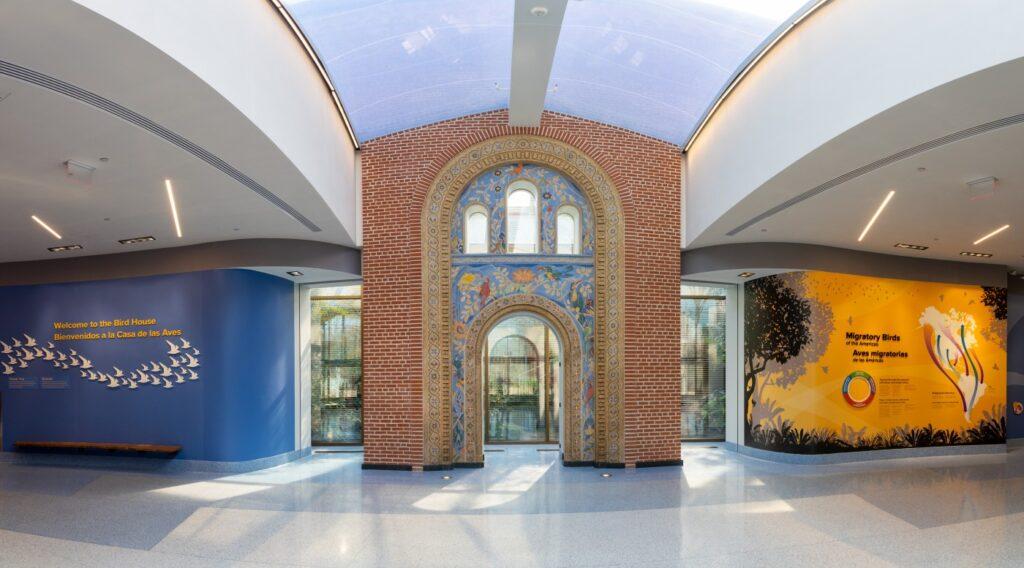Following six years of renovation, the Smithsonian National Zoo’s Bird House reopened to the public on March 13. The exhibit is housed in a sleek new building, inspired by the plumage of the sandhill crane. Upon entering, visitors are greeted with a mosaic tile archway that has been part of the Bird House since it first opened in 1928.
The Bird House is composed of three aviaries that aim to tell the story of the annual cycle of a migratory bird, focusing on migration, breeding and overwintering, the phase in which birds wait out the winter. The Bird House also focuses on informing its visitors about how bird populations are being threatened by factors such as deforestation.

The renovated Bird House is notable in that visitors can experience the presence of the birds up close and with no barriers.
Peter Marra, the director of the Earth Commons at Georgetown and a former senior scientist at the Smithsonian Migratory Bird Center, worked on the design of the new Bird House for eight years. According to Marra, the goal of the renovation was to offer a more immersive experience for visitors.
“As a person experiencing the exhibit, you yourself would almost be on a migration,” Marra said
Daisy Fynewever (CAS ’26), an avid bird enthusiast, visited the Bird House shortly after its reopening and said the interactive component was the most enjoyable part of her experience.
“I loved that I was able to see the birds so up close,” Fynewever told The Hoya. “I felt like I could’ve spent hours in the exhibit, watching the birds and their behavior.”
To prepare for this new experience, the Smithsonian had to ensure that the birds could acclimate to the presence of visitors. The birds are first introduced to the keepers so that they are already accustomed to people as more and more visitors arrive. The birds were also introduced to service dogs to ensure they are exposed to situations that could emerge once the House opened to visitors, according to Marra.
The first aviary of the exhibit that visitors enter is all about migration and the presence of shorebirds on the Delaware Bay. The exhibit simulates the Delaware Bay’s water bodies, sandy shores and water life, including horseshoe crabs. The shorebirds land at the Delaware Bay because of horseshoe crab eggs, one of their preferred food sources.
When it comes to feeding in the Bird House, Marra emphasized the importance of making sure the birds are well nourished, but also challenged to earn their food.
“It is a process of positive reinforcement over time to eventually get them to find the food,” Marra said.
The visitor then enters the second aviary, which is focused on duck breeding grounds. In the summertime, many ducks breed in the Prairie Pothole region of Canada and the northern United States, and the aviary is meant to simulate this environment. Here, visitors can see many different species of ducks as well as their eggs.
The third aviary highlights migratory birds’ journey south to the tropics of South America during winter. Walking in, the visitor is immediately met with a misty, humid environment with parakeets and other songbirds flying around.
“The habitat the birds were in felt very well designed, so you could see the birds doing many different activities,” Fynewever said.
The third aviary also highlights how birds can thrive in shade-grown coffee plantations as opposed to sun-grown, or monocrop, coffee plantations. Monocrop coffee production is significantly cheaper, but requires the removal of native trees that sustain the natural habitat; in Central America, over 2.5 million acres of land have been cleared because of the switch from shade-grown coffee to monocrop coffee growing.
“We are trying to illustrate how you can drink coffee and other foods in a sustainable way,” Marra says.
The exhibit offers visitors a new experience of understanding migratory birds, which is particularly important because so many of these species are becoming endangered.
If you have a couple of hours, check out the free exhibit to see all that it has to offer — but be prepared to be splashed by a duck.









